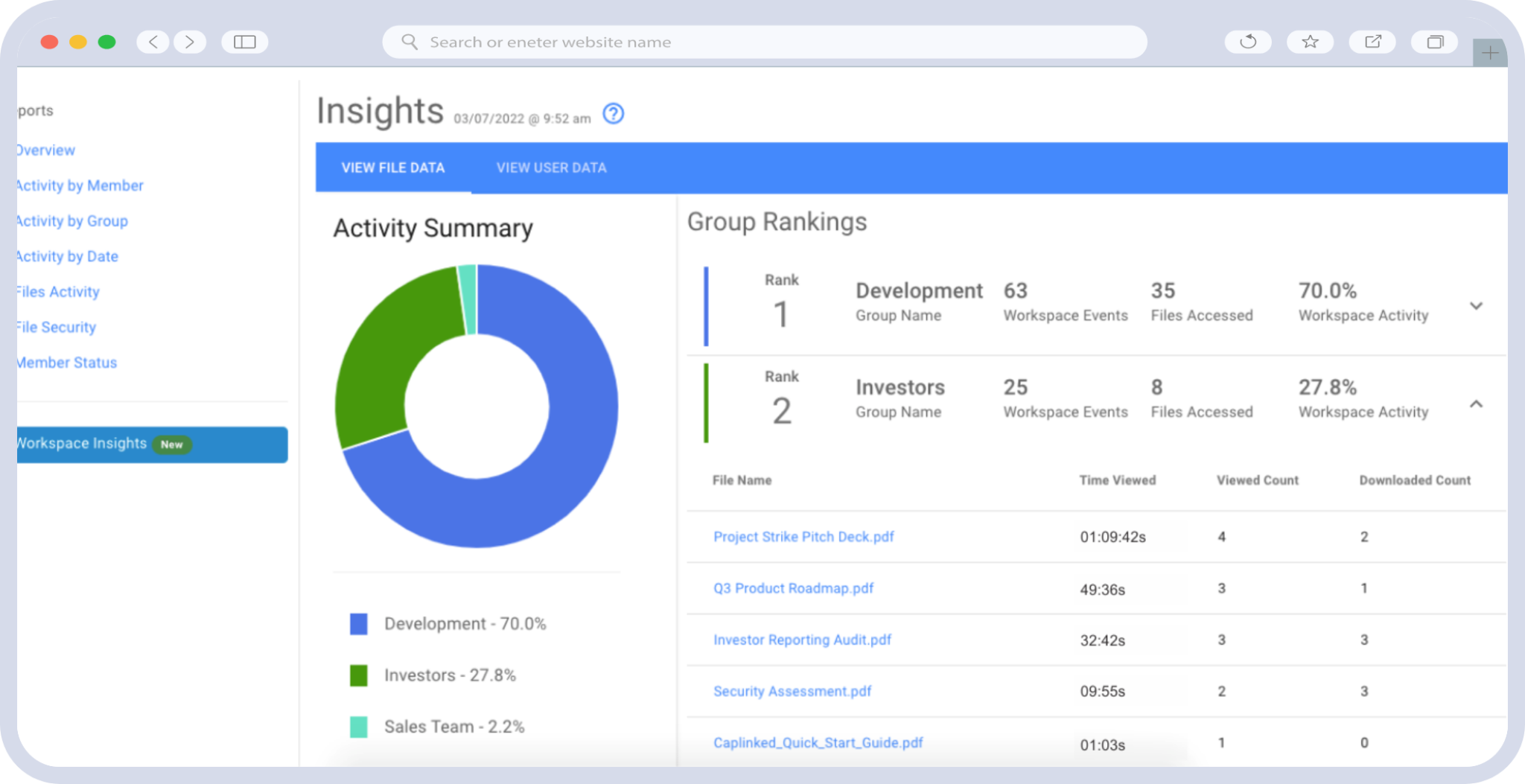By late 2025, FedRAMP High has become a dividing line in the secure collaboration market. On one side: platforms that can prove compliance. On the other: everyone else who can only claim it.
For companies handling federal data—or even contracting with agencies that do—the Federal Risk and Authorization Management Program (FedRAMP) defines whether your cloud platform is usable at all. But inside that program, High Impact Level authorization sits at the top. It’s the standard used by defense, justice, and health agencies—places where a single misconfiguration can mean mission compromise or regulatory exposure.
In this landscape, AWS GovCloud and the few SaaS platforms built on it stand apart. They aren’t just compliant—they’re pre-cleared for operations that touch sensitive but unclassified information. For virtual data rooms (VDRs), that means a compliance inheritance model that accelerates due diligence, reduces audit friction, and keeps deals moving even under government oversight.
FedRAMP in Plain Terms
FedRAMP isn’t new—but most teams still misunderstand it.
At its core, the program standardizes how the U.S. government evaluates and authorizes cloud services. Instead of every agency running its own audit, FedRAMP creates a centralized process and shared controls catalog (based on NIST 800-53).
There are three baselines:
- Low: For systems with minimal risk to confidentiality, integrity, or availability (e.g., public websites).
- Moderate: For most controlled but non-critical data.
- High: For systems where data loss could cause severe impact on operations, reputation, or individuals.
High authorization requires roughly 420+ controls—covering physical data center security, encryption, access management, monitoring, incident response, and supply chain risk.
For agencies, only High-level environments can handle mission-critical or law-enforcement data. For vendors, it’s the only way to serve those customers legally.
Why VDRs Hit the FedRAMP Wall
Virtual data rooms sit at the intersection of sensitive information and external access. Every diligence process involves dozens—or hundreds—of outside users touching confidential files: investors, lawyers, consultants, acquirers, and auditors.
That’s a compliance nightmare without strict access control, audit logging, and data segregation.
Legacy VDRs built on commercial cloud environments fail on three counts:
- They lack FedRAMP inheritance. Commercial AWS or Azure regions only reach FedRAMP Moderate at best. That disqualifies them for defense, justice, and certain civilian workloads.
- They lack personnel screening. Many FedRAMP High systems require U.S.-citizen administration. Multi-national support teams can’t meet that bar.
- They lack isolated infrastructure. Multi-tenant commercial clouds risk cross-region data leakage and inconsistent encryption enforcement.
The result: agencies and primes can’t legally host sensitive collaboration there—no matter how many times “secure” appears in marketing.
AWS GovCloud: The FedRAMP High Shortcut
When AWS created GovCloud in 2011, it solved these problems in one stroke.
GovCloud is pre-authorized at the FedRAMP High JAB Provisional ATO level. That means it has already been evaluated by the Joint Authorization Board (GSA, DoD, DHS). Vendors who build SaaS platforms in GovCloud inherit that authorization for roughly 75% of required controls—everything from data center security to encryption key management.
For a VDR vendor, that inheritance changes the economics of compliance:
- No need to prove physical security or personnel vetting—the cloud provider handles it.
- Faster audit cycles—agencies can reference AWS’s FedRAMP documentation.
- Easier ATO renewals—control inheritance limits what must be re-assessed each year.
A FedRAMP High VDR built on GovCloud can move from design to operational status in months instead of years—without cutting corners.
What “High” Really Covers
A FedRAMP High environment guarantees that core infrastructure meets rigorous technical standards across:
- Access Control: Role-based, least-privilege, multi-factor enforced.
- Audit & Accountability: Centralized, immutable logging of every event.
- Configuration Management: Versioned baselines and continuous monitoring.
- Incident Response: Documented playbooks, reporting windows, and escalation paths.
- Media Protection: Encryption at rest and in transit, verified through FIPS 140-2 modules.
- Physical & Environmental Security: 24/7 guarded data centers with layered access control.
- Personnel Security: U.S. citizenship and background checks for administrators.
- System Integrity: Continuous vulnerability scanning and patch management.
For a VDR operator, that infrastructure backbone enables fine-grained application controls—like file-level permissions, document expiration, and access watermarking—without building them from scratch.
Why It Doesn’t Slow Deals Down
There’s a persistent myth that compliance slows deal velocity. In truth, it’s bad architecture—not security—that slows things down.
GovCloud provides all the elasticity and performance of commercial AWS, just with added security boundaries. That means a FedRAMP High VDR can scale instantly for due diligence surges while staying inside regulatory guardrails.
In CapLinked’s architecture, users can spin up new deal rooms in hours—each mapped to its own encrypted S3 bucket, key hierarchy, and audit log stream—without re-certifying anything. Compliance is baked in, not bolted on.
Compliance Inheritance in Action
Consider a defense contractor acquiring a software firm that handles export-controlled technical data. The acquiring team needs a workspace that can:
- Limit access to U.S. persons only
- Maintain audit logs for five years
- Encrypt data with customer-managed keys
- Operate under a FedRAMP High enclave
A CapLinked VDR on GovCloud inherits AWS’s FedRAMP High controls, adds app-layer safeguards (granular permissions, watermarking, and document expiry), and delivers a ready-to-audit environment in less than 48 hours.
The same workflow on a non-FedRAMP environment could take weeks of approvals—or never pass review at all.
FedRAMP vs. SOC 2 vs. ISO: Why It Matters
Many vendors cite SOC 2 Type II or ISO 27001 certifications as proof of security. Those frameworks are valuable—but they’re not equivalent to FedRAMP High.
| Framework | Governing Body | Focus | Applicability |
|---|---|---|---|
| SOC 2 Type II | AICPA | Controls over data privacy and operations | Private-sector assurance; not government-specific |
| ISO 27001 | ISO/IEC | Information security management system (ISMS) | Global best practice baseline |
| FedRAMP High | U.S. Government (JAB) | NIST 800-53 High controls | Mandatory for U.S. government data |
In short: SOC 2 or ISO proves good governance. FedRAMP High proves government-grade compliance. For any VDR handling defense, law enforcement, or federal contracting data, only the latter qualifies.
Real-World Advantages for Capital Markets and M&A
While FedRAMP originated in government, its benefits now extend to private markets. Financial institutions, healthcare conglomerates, and infrastructure operators increasingly adopt GovCloud-based systems to ensure they can handle federally regulated data if required.
When a capital markets team runs diligence in a FedRAMP High VDR, they gain:
- Regulatory readiness for SEC, DoD, or CFIUS audits
- Cross-border assurance when dealing with U.S. affiliates
- Higher valuation confidence—compliance baked into the transaction record
As investors demand greater transparency around cyber risk, hosting sensitive deal data on a compliant foundation signals professionalism and resilience.
Building Once, Reusing Everywhere
One of the unspoken advantages of GovCloud deployment is control inheritance across products. Once a vendor implements FedRAMP High-aligned architecture, that framework can extend to multiple SaaS offerings: internal collaboration, compliance monitoring, secure data exchange.
This “build once, reuse everywhere” model reduces marginal compliance costs while multiplying market eligibility. That’s how firms like CapLinked expand from corporate VDRs into government-grade environments without fragmenting their stack.
The Bottom Line: Compliance as a Growth Enabler
FedRAMP High used to be viewed as a gate. In 2025, it’s a growth channel.
For VDR providers and deal teams, it unlocks new categories of clients—federal, defense, energy, and healthcare—while proving maturity to commercial buyers who now expect the same standards.
And for agencies, it offers a faster route to digital collaboration that’s secure by default.
When compliance becomes architecture, not bureaucracy, everyone wins.



